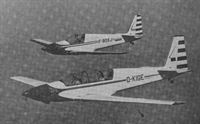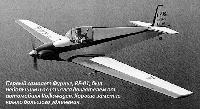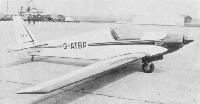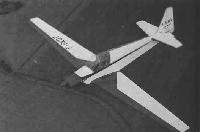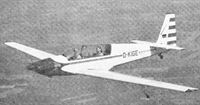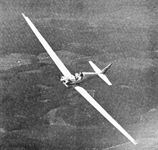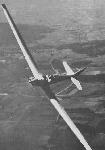Самолеты Фурнье
В 1960 году Рене Фурнье сконструировал и построил одноместный сверхлегкий самолет Fournier RF-01, который имел очень простую конструкцию и оснащался модифицированным автомобильным четырехцилиндровым двигателем Volkswagen с горизонтальным расположением цилиндров и мощностью 25 л.с. (18,5 кВт). После успешных испытаний прототипа французское правительство решило оказать поддержку проекту и выделило средства на запуск машины в серийное производство.
Вскоре вслед за вторым прототипом RF-01 и двумя предсерийными машинами RF-2 последовал серийный вариант RF-3, совершивший первый полет в марте 1963 года. В июне того же года самолет завершил сертификацию, и с ноября начались поставки серийных самолетов заказчикам.
К тому времени Фурнье уже заключил соглашение о сотрудничестве с компанией "Alpavia SA", которая и стала ответственной за выпуск самолетов RF-3, собрав в общей сложности 95 машин, после чего переключилась на выпуск более совершенной модели RF-4D. В 1966 году в ФРГ компания "Sportavia-Putzer" приступила к постройке самолетов серии RF - всего были собраны 160 самолетов RF-4D. Некоторые из этих самолетов добились впечатляющих результатов, например, в мае 1969 года Миро Словак на RF-4D в одиночку перелетел через Северную Атлантику и выиграл приз на трансатлантических гонках. Более поздними разработками на основе базового проекта RF-4 стали удлиненный двухместный самолет RF-5 и самолет Sportavia SFS 31 Milan, отличавшийся фюзеляжем и хвостовым оперением от самолета RF-4 и крылом от Scheibe SF-27M, имевшим размах 15 м.
<...>
Показать полностьюShow all
M.Hardy. Gliders & Sailplanes of the world
Alpavia Avion-Planeur RF3
This single-seater low wing motor glider was the first of a series of such types designed by M Rene Fournier to go into production, and to be built by several different companies in France and Germany. The RF3 was developed from the prototype Avion-Planeur, known as the Fournier RF01, which first flew on 6 July 1960. It proved to be so successful that the French Government helped to finance the building of two RF2 pre-production prototypes, the first of which flew in June 1962, and later ordered six of the production version, the RF3, for national flying clubs; the first RF3 made its maiden flight in March 1963 and received its C of A on 7 June that year. Rene Fournier entered into partnership with Comte Antoine d'Assche of Alpavia SA, which had been building Jodel D117s, and this firm took on the production of the RF3, building a total of 95 in all; deliveries started in November 1963. Although the engine can be stopped and restarted in flight and the RF3 is capable of prolonged soaring flights - many such flights of up to five hours have been made - the type should not be regarded as just a powered sailplane, as it has a high performance and is capable of all simple aerobatic manoeuvres such as stall turns, loops, half-rolls, slow rolls and spins. This performance was soon being proved in service, one notable flight in the winter of 1963-64 being made by an RF3 pilot over St Auban in the Basses-Alpes region, who climbed to 19,700ft after stopping his engine at 6,500ft. Another RF3 was successfully operated in the French Alps with a mono-ski landing gear replacing the retractable monowheel. The engine is a 39hp modified version of the Volkswagen 1,200cc 'flat four' car engine, converted by the Rectimo Co of Chambery. The only modifications are the fitting of a special Zenith carburettor, a propeller shaft and a Bendix magneto of the type used on the 65hp Continental engine. For restarting in flight, an optional mechanical system pushes the four exhaust valves in simultaneously, enabling the propeller to start the engine during a dive at 90 mph; a two-blade wooden prop made by Evra or Helice Legere is fitted, and there is a single 6.5 Imp gallon fuel tank in the fuselage.
Of all-wood construction, the RF3 has a single-spar one-piece wing with 4° dihedral and plywood and fabric covering, attached to the fuselage by four bolts. The ailerons are fabric-covered and there are no flaps, but instead a three-section air brake in the upper surface of each wing inboard of the ailerons. The wooden fuselage is plywood-covered, the pilot sitting under a moulded one-piece canopy; radio and oxygen equipment are among the optional 'extras'. The monowheel has rubber chord shock absorption and retracts forward manually into a glassfibre cowling; it has a manually-operated brake and is supplemented by a hoop-shaped balancer skid of 6mm steel wire under each wing. There is also a steerable tailwheel. The cantilever wooden tail unit has a trim tab in the rudder.
Span: 36 ft 9 in
Length: 19 ft 8 in
Wing area: 118.0 sqft
Aspect ratio: 11.0
Empty weight: 529 lb
Max weight: 772 lb
Max level speed: 118 mph
Max cruising speed: 112 mph
Min sinking speed: 3.94 ft/sec
Take-off run to 50 ft: 875 ft
Range with max fuel: 310 miles
Sportavia Avion-Planeur RF4D
Although very similar in appearance to the Alpavia Avion-Planeur RF3, the RF4 has been completely redesigned and restressed to make it fully aerobatic, with a safety factor of 13 at full loading. Three prototype RF4s were built in France by Alpavia SA but in 1966 the letter's director, Comte Antoine d'Assche, formed Sportavia-Putzer GmbH und Co K.G. with Alfons Putzer to take over manufacture of the Avion-Planeur series form Alpavia, and production of the RF4 started at Dahlemer Binz in Germany. By the spring of 1971 a total of 160 RF4Ds had been built and exported to a number of countries, this being the production version with a main spar of laminated pine, giving increased structural strength for aerobatics. All plywood covering is of Finnish birch, the Frise-type fabric-covered ailerons are aerodynamically compensated, the underside of the fuselage is now rounded instead of flat as on the RF3, and the wing/fuselage junction has been improved. Other differences from the RF3 include revised exhaust silencing and capacity of the single fuel tank in the fuselage increased to 8.4 Imp gallons, with a 5.5 Imp gallons auxiliary tank optional. A notable flight was made by M. J. Slovak in RF4D N1700, who crossed the Atlantic in May 1969 in 175hr 42min 7.11sec to win the Evening News £1,000 prize for the best performance in that year's Daily Mail air race by a light aircraft of under 5,000lb weight. Structurally the RF4D is very similar to the RF3, except for the necessary strengthening to make it fully aerobatic; the entire tail unit can now be detached for transportation, and the three-section spoilers in each wing upper surface are metal-skinned. The landing gear is very similar, with the addition of a parking brake, and a ski landing gear is offered as an optional installation. The pilot's canopy opens sideways to starboard, and there is a baggage space aft of his seat; VHF radio and an oxygen system are optional. The engine is a 40hp Rectimo 4 AR 1200 converted 1,200cc Volkswagen 'flat four' car engine driving a Hoffman two-blade fixed-pitch wooden propeller of 4ft 4in diameter; as on the RF3, this can be stopped and restarted in flight.
A later development of the RF4D was the Avion-Planeur RF7 which was very similar to it except for a wing span reduced to 30ft 10in, an increased tailplane span and a more powerful engine very similar to the RF5's. Construction of the prototype RF7 began in July 1969 and it first flew on 5 March 1970. Powerplant is a 68hp Sportavia-Limbach SL 1700D dual ignition 'flat four' engine driving a Hoffman two-blade fixed pitch metal propeller of 4ft 9 3/4 in diameter, and the RF7 has the same fuel tankage as the RF4D. Wing area is now 108sq ft and aspect ratio is 8.8; the maximum cruising speed at sea level is now 137mph.
Span: 36 ft 11 1/4 in
Length: 19 ft 10 1/4 in
Height: 5 ft 1 3/4 in
Wing area: 121.7 sqft
Aspect ratio: 11.2
Empty weight: 584 lb
Max weight: 859 lb
Max level speed: 122 mph
Max cruising speed: 112 mph
Min sinking speed: 4.27 ft/sec
Best glide ratio: 20:1
Take-off run to 50 ft: 875 ft
Range with max fuel: 422 miles
Sportavia Avion-Planeur RF5
The RF5 is basically a tandem two-seater version of the RF4D and RF3, differing from them mainly in having wings of increased span, with folding outer sections to facilitate hangar storage, and a more powerful engine. Dual controls are fitted, the pupil sitting in the forward seat when under instruction, this seat being occupied by the pilot when the aircraft is flown solo. Construction of the prototype RF5, registered D-KOLT, was started in the summer of 1967, and it first flew in January 1968. Production started late that year, and a total of 145 RF5s had been delivered by the end of 1978; production ended in the spring of 1979. The RF5 received its German domestic type certification in the powered sailplane category in March 1969. The wings are very similar structurally to the RF4D's with slightly less dihedral (3° 15') at the main spar centre-line; the outer wing panels fold inwards, and the same type of metal-skinned spoilers are fitted in the upper surfaces. The wooden oval-section fuselage is made up of bulkheads and stringers, and is ply- and fabric-covered. The cantilever wooden tail unit is similarly covered, and has a fixed-incidence tailplane with a Flettner trim tab in the port elevator; the entire tail can be removed for transportation. Landing gear is similar to the RF4D's, the single Tost mainwheel having twin oleo-pneumatic shock absorbers and a manually-operated brake and retracting forward with spring assistance; there is a steerable tailwheel with oleo-pneumatic shock absorber, and small outrigger wheels under each wing, just inboard of the fold line. The powerplant is a 68hp Sportavia-Limbach SL 1700E Comet 'flat four' engine with a maximum continuous rating of 63hp and driving a Hoffman two-blade fixed-pitch metal propeller of 4ft 9 3/4 in diameter. Two metal fuel tanks in the wing root leading edges give a total capacity of 13.8 Imp gallons. The pilot and pupil or passenger sit under a one-piece sideways-hinged Plexiglas canopy, with a small baggage space aft of the rear seat; rudder pedals are adjustable and the canopy can be jettisoned in emergency. Optional equipment includes VHF radio, radio compass, VOR, ADF, oxygen, navigation and landing lights and a rotating beacon.
The RF5D is an improved 1974 model of the RF5 incorporating the full range of improvements introduced on the RF5B Sperber in 1973, and with a more powerful (74hp) Sportavia-Limbach SL 1700ED engine.
Span: 45 ft 1 in
Length: 25 ft 7 1/4 in
Height: 6 ft 5 in
Wing area: 162.8 sqft
Aspect ratio: 12.25
Empty weight: 926 lb
Max weight: 1,433 lb
Max level speed: 124 mph at sea level
Max cruising speed: 112 mph
Min sinking speed: 4.59 ft/sec
Best glide ratio: 22:1
Take-off run: 655 ft
Range with max fuel: 472 miles
Sportavia RF5B Sperber
The RF5B Sperber (or Sparrowhawk) is an improved version of the RF5 differing from it chiefly in having the wing span increased by 10ft 9in and the rear fuselage cut down to give improved rearward visibility from the new bulged sideways-opening cockpit canopy, and to reduce the side area. Construction of the prototype began in early 1971 and it first flew in May of that year. The RF5B received German certification in the motor glider category in March 1972, and by the spring of 1977 a total of 80 RF5Bs had been delivered; from 1979 it is only available to a firm order. In 1973 several modifications were introduced on production aircraft including an improved cabin heating system; an engine muffler to decrease exterior and cabin noise levels; an adjustable ventilation system; optional disc brakes and a wider range of instrument and equipment optional 'extras', which now include an artificial horizon, electric compass and a flight data computer. The same 68hp Sportavia-Limbach SL 1700E Comet engine as on the RF5 is fitted, although the SL 1700E1 of the same horsepower can be fitted optionally, this variant being equipped to drive the Hoffman HO-V62R two-blade three-position variable-pitch propeller that is available as an alternative to the fixed-pitch prop. All fuel is now contained in a single fuselage fuel tank of 8.6 Imp gallons capacity. The RF55, which first flew in 1972, was a modified version of the RF5B fitted with a slightly-modified 60hp Franklin 2A-120-A engine to meet overseas certification requirements; an electric fuel pump was featured, as well as a larger fuel tank; this version did not go into production.
Span: 55 ft 10 in
Length: 25 ft 3 1/4 in
Height: 6 ft 5 in
Wing area: 204.5 sq ft
Aspect ratio: 15.25
Empty weight: 1,014 lb
Max weight: 1,499 lb
Max level speed: 118 mph
Max cruising speed: 112 mph
Min sinking speed: 2.92 ft/sec at 46.5 mph
Best glide ratio: 26:1 at 61 mph
Take-off run: 615 ft
Range with max fuel: 261 miles
Sportavia SFS 31 Milan
This single-seat motor glider was produced by combining the Avion-Planeur RF4D's fuselage and tail unit with the wings of the Scheibe SF-27M, which is a powered version of the SF-27 Zugvogel V singleseater Standard Class sailplane. The Milan's designation is formed by adding together the manufacturers' initial letters and the numbers in the designations of these two aircraft, and the SFS 31 was produced jointly by Sportavia and Scheibe. The Milan prototype, D-KORO, made its first flight on 31 August 1969. The cantilever wings are low-set instead of in the shoulder position of the SF-27M and Zugvogel V, with 4° dihedral from the roots, and are wooden structures with a pine box spar and plywood ribs covered with birch plywood and fabric; Schempp-Hirth glassfibre/metal air brakes are fitted in the upper surfaces. The SF-27M's wings were made stronger than those of the unpowered SF-27 Zugvogel V, and it is powered by a 26hp Hirth Solo vertically-opposed four-cylinder engine retracted manually backwards into the fuselage, being completely enclosed behind closed doors. The Milan's powerplant is a 39hp Rectimo (converted Volkswagen) 4 AR 1200 'flat four' engine in a conventional tractor installation, driving a Hoffman two-blade fixed-pitch or fully-feathering wooden propeller, of 4ft 4in of 4ft 5 1/2 in diameter respectively. The single fuel tank in the fuselage has a capacity of 7.7 Imp gallons. The landing gear is similar to the RF4D's, but with spring-assisted retraction of the main wheel.
Span: 49 ft 2 1/2 in
Length: 19 ft 10 1/4 in
Height: 5 ft 1 3/4 in
Wing area: 129.0 sq ft
Aspect ratio: 18.6
Empty weight: 661 Ib
Max weight: 948 lb
Max cruising speed: 112 mph at sea level
Min sinking speed: 2.8 ft/sec
Best glide ratio: 29:1
Take-off run: 690 ft
Range with max fuel: 415 miles
Показать полностьюShow all
Jane's Encyclopedia of Aviation
Sportavia RF5B Sperber (Germany)
Tandem two-seat motor glider powered by a 50.7 kW (68 hp) Limbach SL 1700 E Comet engine. Improved high-performance version of the Avion-Planeur RF5.
Sportavia SFS 31 Milan (Germany)
Essentially a combination of the Avion-Planeur RF4D fuselage and tail unit with the wings of the Scheibe SF-27K sailplane, producing a single-seat light monoplane powered by a 29 kW (39 hp) Rectimo 4 AR 1200 engine.
Sportavia Avion-Planeur RF4 (Germany)
Single-seat motor glider combining the characteristics of a small sporting aeroplane and a training sailplane. Powered by a 30 kW (40 hp) converted Volkswagen 1,200 cc motorcar engine. Sportavia took over production of the Avion-Planeur series (designed by Fournier) from Alpavia in 1966.
Sportavia Avion-Planeur RF5 (Germany)
Two-seat motor glider powered by a 50.7 kW (68 hp) Limbach SL 1700 E Comet engine.
Показать полностьюShow all


